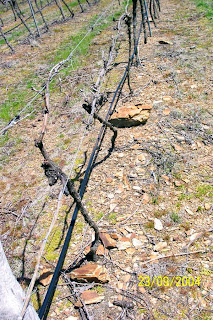Monday, September 23, 2013
Soils ain't soils, Sol.
This being the beginning of another growing season here at Bloodwood, I thought it time to get really filthy for a change; thought it time to get our hands well and truly soiled.
When you are selecting the site for your new vineyard, there's a lot to be said for dirt. Not only is it a fairly handy medium in which to stand trellis posts but it can also play a critical role in the quality of your fruit.
You see, vines will grow almost anywhere as "those opposite" continually point out to me during cellar door tastings. This business about one area being able to produce wine while that one won't, is just another red herring. Wine grapes are grown and wine is produced in Alice Springs using similar technology to that found in Hobart or Mudgee.
You'll find the winemakers of Griffith just as unimpressed with vintage rains as we are at Bloodwood. There's not a lot anybody can do about bush fires or hail, while floods and droughts are facts of this agricultural life. And yet vineyards pop up all over the place, sometimes in the most unlikely places.
Not all of them succeed, not all of them last for generations, but very few of them fail to make wine of some description or another sooner or later.
The wonderful thing about wines is that no two are identical. Neighbouring wineries can try to level the playing field by growing the same variety on the same trellis, pruned to the same number of buds. They can tend the vines identically and pick their perfectly ripe fruit on the same day; vintage techniques can be identical. And yet, they will make two different wines. These differences may be quite subtle, but they will be there nevertheless. And difference can be all in a wine these days. Just ask the good bergs of Burgundy or Bordeaux if you don't believe me.
The French have been long convinced that soil (and aspect and micro-climate and overall provenance) has a lot to do with these differences. While science tells us that climate is more important in the macro scheme of things, soil, in theirs and my opinion, is an underrated link in the quality chain of every fine wine.
Our vineyard is planted on medium to low fertility gravelly soils over a friable, red clay base, the whole profile interspersed with limestone lenses shale and ancient volcanoclastics. Some of our more unkind colleagues refer to Bloodwood as 'the quarry', and as we had to turn to power gel and short fuses to secure our end posts in the Riesling vineyard..they have a point.
Why gravel? To make quality wines, you need quality grapes. And the critical parameter in such a cool, marginal climate as ours is appropriate ripeness of the fruit. Unlike almost any other Australian wine growing area, acid and pH look after themselves in Orange. However, to make a high quality wine, grapes must ripen enough for flavour to complete the delicate balance in the finished wine.
A deep, high-fertility soil like some of the local, richer red mountain earth orcharding soils allows the mature vine to grow with so much vigour that, through shading and delayed ripening, optimum flavour may not always be achieved even though alcohol levels can be relatively high.
Conversely, those soils which limit vigour, and, in traditional viticultural wisdom, make the vines work for their living, produce wines of more intense flavour,aroma and overall elegance.
In quality viticulture then, under this Bloodwood sun, all soils ain't soils!
Subscribe to:
Post Comments (Atom)

No comments:
Post a Comment